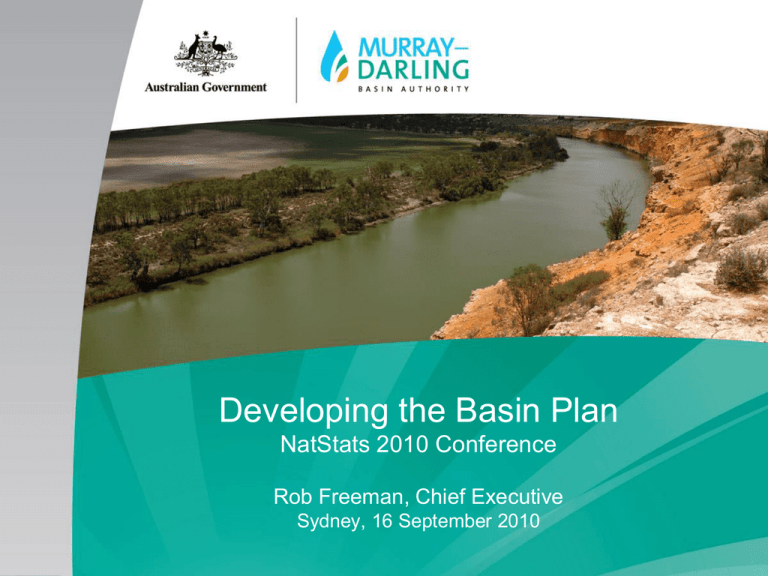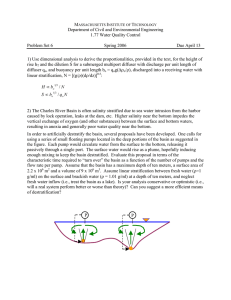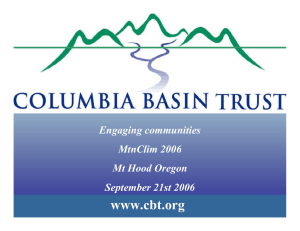Mr Rob freeman.pptx
advertisement

Developing the Basin Plan NatStats 2010 Conference Rob Freeman, Chief Executive Sydney, 16 September 2010 Murray-Darling Basin • Directly supports 3 million people. • Feeds approximately 20 million people. • Significant environmental values. • 14% of Australia. • Australia’s three longest rivers. • 40% Australia’s farmers. • Agricultural exports earn $9 bil/year. • Gross value of agricultural production $15 bil (40% Australia). • Home to 34 major Indigenous groups. Current Planning Total Water Water Use Historical Climate 23,417 11,327 (48%) 2030 Median Climate 20,936 10,876 (52%) 2030 Dry Extreme 15,524 8,962 (58%) (CSIRO Water Availability – 2008) Ecosystem Health Assessments by Valley, 2004-2007 Key Elements of the Basin Plan Page 8 of the Concept Statement Conceptual Cycle • Identify Key Environmental Assets and Key Ecosystem Functions. • Determine environmental water requirements of the Key Environmental Assets and Key Ecosystem Functions. • Calculate possible SDL. • Assess socio-economic impact. • Consider alternative scenarios. • Implement through Environmental Watering Plan. • Simplicity belies complexity. Data Sets Ecological data Variable, multiple formats, different emphasis. Hydrological data Detailed, comprehensive. [CSIRO Sustainable Yields – foundation]. Social and Economic data The big challenge! MDB Surface and groundwater models Warrego IQQM Nebine IQQM Paroo IQQM Lower Balonne IQQM St George SGCS13NT Barwon-Darling IQQM Middle Condamine IQQM Condamine MODFLOW Menindee IQQM Bidgee IQQM Lower Bidgee MODFLOW Murray BigMod Murray MSM Eastern Mt Lofty Ranges 6*WATERCRESS Southern Riverine Plains MODFLOW Wimmera REALM Daily Weekly Monthly Avoca REALM GSM REALM Ovens REALM Mid Bidgee MODFLOW Upper Condamine IQQM Border Rivers MODFLOW Border R. and Mac B. IQQM Moonie IQQM Lower Gwydir MODFLOW Gwydir IQQM Upper Namoi MODFLOW Peel IQQM Namoi IQQM Lower Namoi MODFLOW Macq-Castlereagh 6*IQQM Macquarie MODFLOW Lachlan IQQM Mid-Lachlan MODFLOW Lower Lachlan MODFLOW Snowy SIM_V9 ACTEW REALM Upper Bidgee IQQM The Role of Social and Economic Data • Describe the social and economic fabric of the Basin [ABS / ABARE / BRS Report – Sep 2009]. • Understand the social and economic impacts of new public policy at community, regional, Basin, State and National levels. • Communicate these impacts using common metrics and analysis at these scales. • ‘Best available scientific knowledge and socioeconomic analysis’ (Water Act 2007). Data Challenges • Disaggregate national and state economic data to better understand community and regional contributions. • Aggregate local social data to State, Basin and National impacts. • Effort to re-aggregate existing data for a ‘non-standard geography’ (to ABS) that was still under development (by MDBA). • Evolution of boundaries impeding time-series analysis. • Increasing number of boundaries – CSIRO, Natural Resource Management (CMA’s), water catchments, Basin Plan regions, ABS geography. Data Challenges ABARE AusRegion MDB regions (comparison with WTM regions) The currency of data • ‘Best Available’ agricultural and population data relates to 2005-06. • Much of the exiting analysis and underlying data for models relates to 2006 or 2001. • Challenging to look forward to what might happen when data could already be considered old. • For example, the drought has reportedly changed the face of much of rural Australia in the last 5 years but the data won’t reflect this, as yet. Data issues • High expectations of social and economic data. • Economic data and modelling is designed for national and State purposes but we need to understand the flow on to local and regional areas. • As we extend the use of data at what point are we left with assumptions and no data. • Yet it is increasingly important to more fully understand a local areas contribution to the national wealth. •Concern that once local area data is aggregated the human dimension is lost. How did we progress? • Took advice early – ABS and ABARE were two of the first agencies contacted. • Allowed the ABS to do what they do best – producing the Context statistical report for the Basin (with ABARE and BRS). • Sought regular ongoing advice on developing the short and long term data needs for the Basin plan. • An active dialogue with the ABS (and others) to progress the issues raised. The Future • Strengthening strategic alliances to improve statistical data in the Basin. • Defining data needs early to meet future requirements (Monitoring and Evaluation). • Better using opportunities (Agricultural Census, Agricultural Survey). • Identifying less obvious opportunities (cross agency agreed priorities, question design). Phases and Timelines Feedback www.mdba.gov.au




